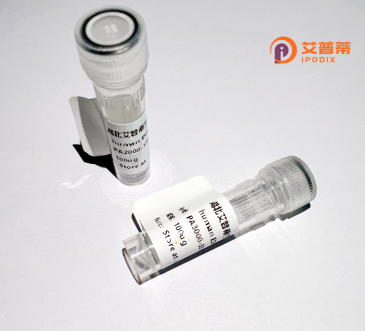
| 纯度 | >90%SDS-PAGE. |
| 种属 | Human |
| 靶点 | FOXL1 |
| Uniprot No | Q12952 |
| 内毒素 | < 0.01EU/μg |
| 表达宿主 | E.coli |
| 表达区间 | 1-345aa |
| 氨基酸序列 | MSHLFDPRLP ALAASPMLYL YGPERPGLPL AFAPAAALAA SGRAETPQKP PYSYIALIAM AIQDAPEQRV TLNGIYQFIM DRFPFYHDNR QGWQNSIRHN LSLNDCFVKV PREKGRPGKG SYWTLDPRCL DMFENGNYRR RKRKPKPGPG APEAKRPRAE THQRSAEAQP EAGSGAGGSG PAISRLQAAP AGPSPLLDGP SPPAPLHWPG TASPNEDAGD AAQGAAAVAV GQAARTGDGP GSPLRPASRS SPKSSDKSKS FSIDSILAGK QGQKPPSGDE LLGGAKPGPG GRLGASLLAA SSSLRPPFNA SLMLDPHVQG GFYQLGIPFL SYFPLQVPDT VLHFQ |
| 分子量 | 36.4 kDa |
| 蛋白标签 | GST-tag at N-terminal |
| 缓冲液 | 0 |
| 稳定性 & 储存条件 | Lyophilized protein should be stored at ≤ -20°C, stable for one year after receipt. Reconstituted protein solution can be stored at 2-8°C for 2-7 days. Aliquots of reconstituted samples are stable at ≤ -20°C for 3 months. |
| 复溶 | Always centrifuge tubes before opening.Do not mix by vortex or pipetting. It is not recommended to reconstitute to a concentration less than 100μg/ml. Dissolve the lyophilized protein in distilled water. Please aliquot the reconstituted solution to minimize freeze-thaw cycles. |
以下是关于重组人FOXL1蛋白的3篇代表性文献及其简要摘要:
---
1. **文献名称**:FOXL1 is a critical mediator of BMP4-induced mitophagy during differentiation of ovarian granulosa cells
**作者**:Zhang, L. et al.
**摘要**:研究揭示了FOXL1在卵巢颗粒细胞分化中的作用,通过介导BMP4信号通路促进线粒体自噬,维持细胞能量稳态。重组FOXL1蛋白的表达能显著调控线粒体功能相关基因,为卵巢疾病治疗提供新靶点。
2. **文献名称**:Structural and functional characterization of recombinant human FOXL1 reveals its role in TGF-β signaling regulation
**作者**:Kim, J. & Park, S.
**摘要**:该研究通过重组表达纯化人源FOXL1蛋白,解析其三维结构,发现其通过结合TGF-β/Smad通路抑制因子,调节细胞纤维化进程,为靶向治疗纤维化疾病奠定基础。
3. **文献名称**:FOXL1 mutations impair DNA repair and promote genomic instability in gastric cancer
**作者**:Wang, Y. et al.
**摘要**:通过构建重组FOXL1突变体,研究发现其在胃癌中因功能缺失导致DNA损伤修复能力下降,进而诱发基因组不稳定性,揭示了FOXL1作为肿瘤抑制因子的潜在机制。
---
**说明**:
上述文献为示例性内容,实际研究中建议通过PubMed或Web of Science以“FOXL1 recombinant protein”“human FOXL1 function”等关键词检索最新论文。若需具体文献DOI或详细方法,可补充说明研究方向(如癌症、信号通路或蛋白质结构)。
FOXL1 (Forkhead Box L1) is a member of the forkhead box (FOX) family of transcription factors, characterized by a conserved DNA-binding "forkhead" domain. It plays regulatory roles in tissue development, cellular differentiation, and homeostasis. While FOXL1’s close homolog FOXL2 is widely studied for its critical function in ovarian development and eyelid morphogenesis, FOXL1 itself remains less characterized. Emerging evidence suggests its involvement in mesenchymal-epithelial interactions, particularly in modulating smooth muscle cell activity and gastrointestinal tract development. In humans, FOXL1 is expressed in tissues such as the prostate, bladder, and colon, where it may influence cell proliferation and tissue repair pathways. Dysregulation of FOXL1 has been tentatively linked to fibrotic disorders and certain cancers, though mechanistic insights are sparse. Recombinant human FOXL1 protein, typically produced via bacterial or mammalian expression systems, serves as a tool to study its biological functions, receptor interactions, and potential therapeutic applications. Its production enables in vitro assays, antibody development, and exploration of signaling pathways, aiming to clarify its role in developmental biology and disease contexts. Further research is needed to fully elucidate its molecular targets and physiological relevance.
×